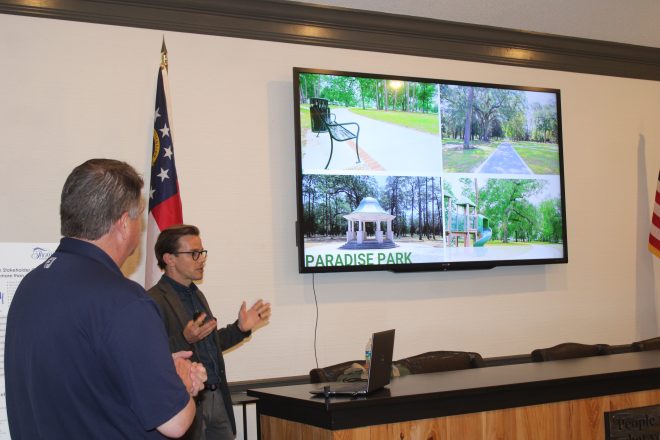Plantation on front of 2004 travel guide
Published 10:17 am Friday, December 9, 2005
THOMASVILLE — One of the crown jewels of southwest Georgia tourism is now the centerpiece of America’s No. 1 state tourism travel guide.
Thomasville’s Pebble Hill Plantation is featured on the cover of the 2004 Georgia On My Mind travel guide that was unveiled along with a new state map by the Georgia Department of Industry, Trade and Tourism (GDITT) at a special ceremony held at the plantation Wednesday.
The new travel guide, which is one of the primary marketing tools used by the GDITT to showcase Georgia attractions and destinations, is a by-product of industry collaboration. The top-ranked guide is assembled using information contributed by tourism industry partners.
Pebble Hill General Manager Wallace Goodman and Thomasville City Council member Camille Payne were in attendance to greet visitors and members of the media and introduced GDITT and Georgia Department of Transportation (DOT) officials who played key roles in producing the new map and extensive travel guide.
Goodman couldn’t have been more trilled that Pebble Hill was chosen for the cover and said that the exposure will raise awareness about Pebble Hill, Thomasville and all of southwest Georgia.
“We think it is the crown jewel in tourism in southwestern Georgia, perhaps in Georgia, and in our minds, the United States,” Goodman said amiably. “Pebble Hill is a great American historic site which is preserving a lifestyle that is quickly fading.”
Janis Cannon, GDITT deputy commissioner of tourism and native of Valdosta, is proud of the new travel guide that is rated among the top state travel editions in the nation by Randall Travel Marketing for the third year in a row.
“The Georgia On My Mind travel guide is a storybook that captures the essence and heart of Georgia and serves as the tourism yellow pages,” Cannon said. “It describes what to see and do in the state through the use of editorial, photography, regional recipes, contact information and much more. It helps people effectively plan everything from day trips to extended vacations.”
Phil Jacobs, Georgia operations president for BellSouth, gave the keynote speech. He directly linked Georgia’s economic livelihood with Georgia’s tourism industry.
“We have so many venues that so many people can visit,” Jacobs said. “We are under-invested in tourism in the state. We don’t advertise the assets that we have in our state nearly to its potential.”
With the state budget lacking revenue dollars, Jacobs sees tourism as a real-time generator of the much-needed revenue.
“This is a great opportunity to generate tax revenues for the state, which is a great benefit for all of us,” Jacobs said. “It reduces our tax obligation and it is a great opportunity as we come out of this economic recession that we are in, and as we struggle with (state) budget issues, we can say, ‘Here’s a place where we can invest money and get an almost immediate return.'”
Jacobs, who also serves as president of the Georgia Chamber of Commerce, said that statistics show that for every dollar for incremental advertising the state puts forth, it generates, just in state tax dollars, between seven and eight additional state tax dollars within 90 days.
“One of the messages that we’re really delivering to the General Assembly in this year of budget cuts is it’s not the right idea to cut budgets as they pertain to adverting and tourism,” Jacobs said. “It’s a place to spend money to generate additional tax dollars.”
The Georgia Tourism Division teamed with GDOT to produce the informative state highway map that encourages visitation and highlights tourism attractions across the state.
By printing one state map instead of two, Georgia saves more than $200,000 in 2004 and increases the number of maps available for visitor distribution to 1.5 million. The highway maps will be available at the Georgia Visitor Information Centers (VIC), local visitor centers, travel and conquers shows, and through bulk requests and fulfillment.
“The new GDITT/GDOT State map is a great example of the power of partnership among state agencies,” Cannon said. “The maps help promote the state as a prominent leisure travel destination.”
Georgia’s tourism industry is the state’s second largest industry behind agriculture. According to GDITT, 42 million people visited Georgia in 2002, contributing $23.9 billion in expenditures. The tourism industry in Georgia is also responsible for 207,100 jobs and $5.8 billion in resident wages with state and local governments realizing $1.1 billion in tax revenues. Talk of tourism easing the burden of Georgia taxpayers isn’t just lip service, either. According to the Travel Industry of America 2002 Economic Study, Georgia households annually saved $367 in taxes due to the revenue that tourism produces.
This is good news for the state. In a nation-wide recession that claimed thousands of manufacturing jobs in Georgia, tourism took a hit in some areas but thrived in other parts. This surprised Jacobs and showed him the resilience of the industry and the sustainability of the attractions Georgia offers visitors.
“So much of our tourism industry is directed toward people within the state as well as people who are within driving distance,” Jacobs said. “To some extent, the kind of immediate fear of flying that took place after September 11, we might have even, in some instances, benefited from because people are saying they still want to take vacations. They don’t want to fly. We have so much to offer. We are so accessible from so many other parts of the southeast.
“Clearly if you look at Atlanta, which defines tourism, which is primarily focused on the convention business than what is conventionally defined as tourism, they were hit much harder. Other parts of the state actually survived quite well.”
Georgia Tourism visitation counts have increased substantially in the first nine of 2003, according to GDITT. Projected visitation counts show a 13.3 percent increase over 2002.





